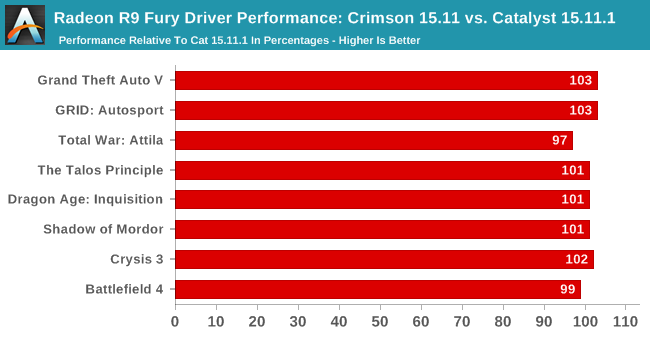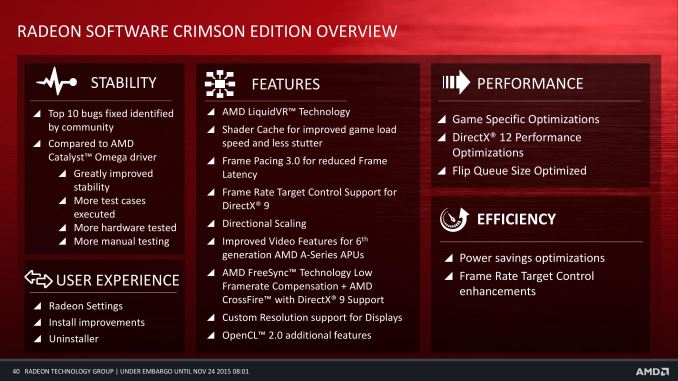AMD's Radeon Software Crimson Driver Released: New Features & A New Look
by Ryan Smith & Daniel Williams on November 24, 2015 8:00 AM ESTCrimson Performance
Last but certainly not least, let’s talk about performance improvements. Like the Omega driver before it, Crimson comes with a collection of performance improvements from AMD’s new driver branch. To preface this with caution, I don’t think anyone should be expecting massive system-wide performance gains – that’s all low-hanging fruit AMD picked long ago – but there’s plenty of room for some lesser optimizations along with game-specific optimizations.
AMD’s own numbers point to game-specific improvements of up to 20%, though it should be noted that AMD’s best-case numbers are on unreleased/beta games that have yet to be well-optimized in the first place. Otherwise AMD’s own numbers are far more tame, listing recently released games with gains between three and five percent.
To take a quick look at general performance, we went ahead and ran our GPU benchmark suite at 2560x1440 on our Radeon R9 Fury (vanilla), comparing the previous Catalyst 15.11.1 beta to the new Radeon Software Crimson 15.11 beta. The Fury and its underlying Fiji GPU is the newest product out of AMD, so it offers AMD the best opportunity to unlock any remaining performance in the architecture.

Overall the average performance gain at 2560x1440 is just 1%. There are a couple of instances where there are small-but-consistent performance gains – Grand Theft Auto V and Grid: Autosport stand out here – but otherwise the performance in our other games is within the margin of error, plus or minus. Not that we were expecting anything different as this never was pitched as a golden driver, but this does make it clear that more significant performance gains are going be on a per-game basis.
Final Thoughts
Wrapping things up, AMD’s development structure in the past year and going forward is one that has both been beneficial to the company and has brought with it its own drawbacks. By focusing feature releases around the end of the year driver, AMD is able to cut down on what parts of the driver they change (and thereby can possibly break) at other times of the year, and try to knock out all of their feature-related bugs at once. At the same time it makes the annual driver release a significant event, as AMD releases a number of new features all at once. However on the other hand this means that AMD has few features launching any other time of the year, which can make it look like they’re not heavily invested in feature development at those points. Then of course there’s the WHQL element, where for multiple reasons AMD hasn’t issued very many WHQL releases this year, and is something they’re seeking to change in 2016.
Looking under the hood there’s no single feature that’s going to blow every Radeon user away at once, but overall there are a number of neat features here that should be welcomed by various user groups. The Freesync Low Framerate Compensation changes should be of particular interest to Freesync users, while shader caching will improve shader loading performance across the board. Otherwise smaller fixes like the DirectX 9 improvements to CrossFire frame pacing, CrossFire Freesync, and framerate target control should be welcome news to APU and dual graphics users.
Meanwhile AMD’s radical overhaul of their control panel via the new Radeon Settings application will be quickly noticed by everyone. Though there’s plenty of room for interpretation on style and just how a good control panel is laid out, AMD has clearly put a lot of effort into cleaning up the layout of their control panel and it shows, as important options are no longer buried under multiple layers of menu trees. And on the performance front Radeon Settings is faster than Catalyst Control Center even on fast machines, and though we haven’t spent much time on covering it, AMD has also managed to speed up the installation process while they were at it. So all-told the Crimson release has something for everyone.
Ultimately I hesitate to ascribe too much of this to the Radeon Technologies Group too soon – this project has clearly been in the works longer than 3 months – but at the same time this is the RTG making their mark. It’s a new direction for AMD’s graphics group and a new look to match. And if the RTG can meet their stability, performance, and release goals going forward with the new Crimson driver, then they should be able to make 2016 a good year for the Radeon user base.


















146 Comments
View All Comments
looncraz - Wednesday, November 25, 2015 - link
The 7970 trashes the 680 in newer games. Shadow of Mordor is nearly twice as fast on a 7970. In addition, the 7970 has been given increased performance with the Crimson driver, whereas the 600 and 700 series have been left to rot.I suspect AMD will keep it up for the next few years since they both need the good will and will also still be selling cards based on GCN, so the fixes and improvements should apply almost universally.
Refuge - Friday, November 27, 2015 - link
They just discontinued driver support for all pre GCN GPU's, so much for that good will eh? lolhttp://www.maximumpc.com/amd-ends-driver-support-f...
Oxford Guy - Thursday, November 26, 2015 - link
I remember the superiority of two versions of its driver bricking cards, including expensive Fermi models.looncraz - Tuesday, November 24, 2015 - link
I don't like Adaptive V-sync at all, can't stand screen tearing. That, and with 144hz monitor and pushing 100+fps, you won't have any lag of which to speak.When the system can't keep up with the monitor, you get tearing... not cool. If you're stuck at 60hz or can't push the frames, then you need to reduce settings or buy a better video card and monitor.
Zeus Hai - Wednesday, November 25, 2015 - link
You're off the point, mate.144Hz, having constant 100+fps on screen (means a very powerful system), new card, new monitor, those are all hardware. And we're talking about driver optimization, software features.
Reduce settings? You will still need Vsync if the fps goes over 60Hz, and what if somehow the fps still can't keep up with the Hz at reduced settings? Triple buffering will worsen the burden, and introduce more lag.
So, adaptive vsync may seem to be simple at first, but actually has some deep thoughts down inside it.
looncraz - Wednesday, November 25, 2015 - link
Why would I have a game fall below 60hz? Not sure I've had that happen since I've bought my R9 290, except for a bugged Crysis mod :pEven then, V-Sync on a 120~144hz monitor introduces a maximum 8ms latency, which is nominally 4ms (statistics and all), which is well inside the reaction time window. Games already have input lag built in, as well as compensation algorithms (for fast-paced games, like BF4). If the game falls below 60hz (16.7ms/frame), then the game itself is introducing dramatically more input lag than V-Sync.
By turning off V-sync, you actually ARE NOT decreasing input lag, either, you are displaying a PARTIAL FRAME. This causes tearing. Monitors STILL only update at their refresh rate, only now you have to deal with tearing. The nominal benefit of turning off V-Sync, on 120hz display, is only 4ms, since that is the only cost from having V-Sync on.
AMD's FreeSync or nVidia's GSync are more appropriate solutions, since the monitor itself will now respond more quickly. This means that the nominal benefit can be 8ms or more.
xdrol - Thursday, November 26, 2015 - link
They actually do, just for some reason it's not enablable (that's a word from now) in the official interface. Install RadeonPro and tada.wav. Or get a FreeSync monitor.Dalamar6 - Wednesday, November 25, 2015 - link
Why look at that, brown nosing shills on a tech forum! Whod'a thunk it!Try using AMD on Arch linux. Or linux in general. There basically are no drivers.
NVidia sucks donkey balls on linux too, but at least they HAVE DRIVERS that don't cripple your system entirely.
AMD has not REALLY improved their drivers in a good 15+ years, why start now?
fluxtatic - Wednesday, November 25, 2015 - link
Why would AMD put any resources into Linux? That sweet 1% marketshare they're missing out on must really be hurting.them. Wait, .5% or less, since NVidia and Intel are in it, too.The whiny entitlement of the Linux crowd gets really, really tired after a while.
Oxford Guy - Thursday, November 26, 2015 - link
The fanbois are just desperate for any pretext to bash. Apparently Linux is now the low-hanging fruit.